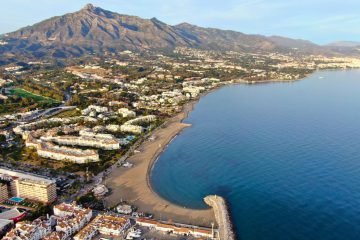Thinking about moving to your dream home on the Costa del Sol? This mortgage guide for the Costa del Sol will take you through the Spanish mortgage types, the buying process, property transfer tax, and every step from making an offer to getting the keys. Whether you’re a Spanish resident or an international buyer, this complete guide will help you compare mortgage rates, get a handle on purchase costs, and secure the best deal for you.
Key Facts for a Costa del Sol Mortgage
- Typical LTV (Loan to Value): up to 80% for Spanish residents looking for a primary residence; 60–70% for non residents and international buyers.
- Minimum deposit: usually 20% for residents and 30-40% for non residents, plus all those extra costs and taxes.
- Mortgage types: fixed rate, variable rate (Euribor + a margin), or a mixed mortgage (fixed period then variable).
- Standard timeline: From submitting mortgage applications to signing in front of a notary – usually 6–10 weeks – if your paperwork is in order.
- Taxes in Andalusia (Costa del Sol): When buying a resale property you pay property transfer tax (ITP), whilst buying a new build you pay VAT (IVA) plus stamp duty (AJD). Andalusia charges a general ITP rate of 7% and AJD around 1.2% – check with the Junta de Andalucía to see what rates are currently applicable before you pay.
- Must-haves: a Spanish bank account, a valuation of the property, a solid purchase contract and an independent lawyer to guide you.
Why Buy Property on the Costa del Sol? Market, Lifestyle, Investment

The Costa del Sol is a great combination of year-round sunshine, plenty of tourists and a really diverse property market that covers Málaga, Benalmádena, Fuengirola, Mijas, Marbella, and Estepona. Property prices vary loads depending on the location, views, what facilities are around, and the quality of the build. Loads of buyers are after a primary residence, a second-home retreat, or a real estate investment for rental income. Your goals define the financing strategy, from fixed-rate certainty for long-term owners to flexible variable options for those planning to sell up or move out early. Remember: community fees, energy performance and local demand can both impact property price and ongoing profitability.
Can You Get a Spanish Mortgage? Residents, Non Residents, and International Buyers

Spanish banks lend to a wide range of buyers – including Spanish residents, EU citizens and non EU citizens – as long as their income, credit report and compliance checks pass the test. Residents often get higher LTVs and sometimes reduced rates for a primary residence, while non residents typically face lower LTV caps due to cross-border risk. Employees, retirees and the self-employed can all get approved – but self-employed applicants will need to provide deeper financials and may see more conservative affordability calculations. Expect banks to target a total debt-to-income ratio of around 30-35% and to stress-test payments against higher interest rates.
How Much Can You Borrow? LTV, Deposits, Affordability, and Valuation

Banks will lend against the lower of the purchase price or the appraised value of the property. That matters if the valuation comes in lower than the sale price – you’ll have to cover the difference in cash. Loads of lenders have a minimum mortgage size – if your loan is small, ask a mortgage broker which banks will consider smaller loans. To estimate how much you can borrow, add up your net monthly income, subtract all other loan payments, and apply a debt-to-income limit (eg 30%). Factor in currency risk if you earn in a different currency to the euro. Always include all the extra costs of buying a property (notary, registry, taxes, valuation, bank fees) on top of your deposit.
Types of Spanish Mortgages on the Costa del Sol

- Fixed-rate mortgage: Your payments stay the same for the full term. Great for budgeting and if you’re after long-term property ownership, especially for a primary residence.
- Variable rate mortgage: Euribor plus a margin (eg Euribor + 1.25%). Payments change at each review period – you’ll benefit if rates fall but pay more if interest rates go up.
- Mixed mortgage: A fixed rate for a few years (eg 5-10) then variable. Useful if you want early certainty with later flexibility.
- Fees and early repayment: Spanish law limits early repayment fees to some extent, but check your FIPER/ESIS to see the exact terms. Compare TIN (nominal rate) and TAE (APR) to ensure you get the total cost – including bank fees and cross-sold products.
All Purchase Costs and Taxes (Andalusia)
Check with your lawyer and the Junta de Andalucía – as rules can change. Typical costs and taxes include:
Resale Purchase Costs (Andalusia)
| Cost/Tax (Resale) | Typical Range | Notes |
|---|---|---|
| Property Transfer Tax (ITP) | ~7% | Andalusia general rate; check applicable reduced rates |
| Notary + Registry + Gestoría | 1,200–2,500 € | Varies by property value |
| Valuation (Tasación) | 300–800 € | Paid upfront |
| Bank Arrangement Fee | 0%–1% | Negotiable; some lenders charge a flat fee |
| Lawyer (Abogado) | 0.5%–1% | Independent from the real estate agent |
New Build Purchase Costs (Andalusia)
| Cost/Tax (New Build) | Typical Range | Notes |
|---|---|---|
| VAT (IVA) | 10% | Most residential new builds |
| Stamp Duty (AJD) | ~1.2% | Andalusia; confirm current rate |
| Other Fees | See above | Notary, registry, valuation, bank, lawyer |
The general rule of thumb is to budget 9-13% of the purchase price for total costs and fees on a resale property and 12-14% for a new build. This will depend on a number of factors including ITP/IVA, AJD and other fees
Step-by-Step Purchasing Process and Mortgage Process in Spain

1) Define your budget and strategy
Set investment goals, choose whether you want this to be your primary residence, a second home or a rental property and estimate total costs. Be clear about your loan to value (LTV) and confirm minimum mortgage thresholds with the banks you are interested in
2) Get pre-approval and open a Spanish bank account
Having pre-approval will boost your credibility with real estate agents and make you a more attractive buyer. Opening the account early will make it easy to pay the deposit, taxes and future loan installments
3) Search with a trusted real estate agent
Shortlist your preferred areas, compare property prices and value, and ask your agent about local rules and regulations, any upcoming work on the property, and the potential rental income if you’re planning to rent out the property
4) Make an offer and pay the reservation/deposit
Quite often a reservation contract will be used. Be sure to negotiate a clause which links it to the mortgage approval. Clarify what happens if the valuation is lower than the purchase price
5) Sign the purchase contract (arras)
Include financing contingencies, penalties and a realistic completion date that gives the bank, lawyer and you the time needed to do the necessary underwriting and legal due diligence
6) Valuation and Underwriting
The bank will order a valuation, check your credit report and income, and assess whether you can afford the mortgage. The amount they are willing to lend will be based on the valuation and will not exceed the loan to value (LTV) cap
7) Final Approval and notary appointment
You will receive the ESIS/FIPER with the final mortgage terms (interest rate, fees). Coordinate with your lawyer and seller to sign and pay at the notary
8) Notary day and registration
You sign the public deed, pay the taxes and fees, and the property is registered in your name. Get the keys once the funds have cleared
Documents Checklist for Mortgage Applications
- Personal documents: Passport, NIE, proof of address, marital status, credit report, last 6-12 months of bank statements
- Income documents: Employees need to provide payslips and contracts. Retirees need to provide pension statements. Self employed individuals need to provide 2-3 years of tax returns, certified accounts, and an accountant’s letter
- Property documents: Nota Simple, energy certificate, LPO/first occupancy license (or equivalent), community fee certificate, purchase contract draft
- Compliance documents: source-of-funds proofs; for international buyers and non EU citizens, expect enhanced KYC by the Spanish bank
Mortgage Broker vs Going Direct to Spanish Banks

A good mortgage broker can compare offers across banks, negotiate margins, and reduce the stress of the process by collecting all of the necessary documentation – especially useful if you’re self employed or not a resident of Spain. Well known firms such as Mortgage Direct operate across the country. Going direct to your Spanish bank may give you relationship benefits or discounted bundles (e.g. home insurance), but you may miss out on the best deal. For this reason, it’s always a good idea to get at least two formal offers and compare APR/TAE including fees before making a decision
Special Buyer Situations on the Costa del Sol

- Primary residence vs second home: Residents buying a primary residence will likely have access to higher LTV and potentially reduced interest rates; second homes and investments will see tighter lending criteria
- Buy-to-let: Banks may discount the expected rental income; test your cash flow with a vacancy buffer
- New build/off-plan: Ensure that the bank guarantees staged payments, and confirm when a valuation can occur
- Golden visa program: Non EU citizens can invest from €500,000 equity; mortgages are allowed on amounts above that threshold. Seek professional advice on structure and residency implications
- Older applicants: Terms may be capped so that the loan ends by a certain age; life insurance may be requested
Legal Requirements, Due Diligence and Professional Advice
Hire an independent lawyer to check on the title, planning status, community debts and any irregularities with the property. Have them verify the Cadastral data, licenses and work out the tax figures before you sign anything. The notary will rubber stamp the deed but it’s your lawyer’s job to do the due diligence. For all the lowdown you can consult the official Banco de España consumer pages, Junta de Andalucía tax portal for ITP/AJD and the Consejo General del Notariado. Links:
- Banco de España: https://clientebancario.bde.es/
- Junta de Andalucía (Taxes): https://juntadeandalucia.es/
- Notaries: https://www.notariado.org/
Timelines and Hitting That Completion Date

Most purchases wrap up in 6-10 weeks, all being well. Delays are usually down to missing papers, unregistered renovations or the valuation coming in lower than you expected. So, make sure your lender, lawyer and real estate agent are all singing off the same hymn sheet. Don’t book the notary until the valuation and underwriting are almost done. And if you hit delays, just renegotiate an addendum to push back your completion date.
Refinancing, Switching Banks and Renegotiating
The two main tools you’ve got at your disposal are novación (renegotiation with your existing bank) and subrogación (switching to a new bank). Compare the costs of switching versus your potential savings. Will the lower margins or ditching any expensive bundles you’re on materially reduce your lifetime costs? And if interest rates drop, or your income goes up, or the market appreciates or you pay in more, refinancing might be a good option.
Costed Examples: From Purchase Price to Total Outlay
Costed Examples: From Purchase Price to Total Outlay
| Scenario | Purchase Price | LTV | Loan | Taxes/Fees (Est.) | Cash Needed at Completion |
|---|---|---|---|---|---|
| Non resident, resale | 400,000 € | 65% | 260,000 € | ~10% (40,000 €) | 140,000 € (deposit + costs) |
| Resident, new build (primary residence) | 700,000 € | 80% | 560,000 € | ~12% (84,000 €) | 224,000 € (deposit + costs) |
Note: Costs include ITP (resale) or IVA+AJD (new build) plus notary, registry, valuation, banks and lawyer. Always check the exact amount with your lawyer.
Quick Comparison: Fixed vs Variable vs Mixed
Payment stability (higher = steadier payments)
Rate risk (higher = more exposure)
If you want a steady payment, go for a fixed rate. If you’re happy to take a chance on interest rate swings or think you’ll pay off early, choose a variable rate. Mixed mortgages split the difference.
Frequently Asked Questions

- What’s the minimum deposit to buy a property on the Costa del Sol?
- Usually 20% for residents and 30-40% for non-residents plus 9-14% for purchase costs and taxes depending on resale vs new build.
- Can international buyers get a Spanish mortgage?
- Yes, Spanish banks lend to international buyers and non EU citizens subject to income proof, credit report and AML/KYC checks.
- What are the current mortgage rates in Spain?
- Rates vary by profile and type. Compare fixed, variable and mixed mortgage offers from multiple banks to find the best mortgage rates and total APR/TAE.
- Do I need a Spanish bank account?
- Yes, you’ll pay the loan, utilities and taxes from a Spanish bank account via direct debit.
- Will banks finance 100% of the purchase price?
- Not usually. LTV caps and valuation rules apply. Plan for a deposit and purchase costs.
Conclusion: Your Mortgage Guide for the Costa del Sol, Simplified

Buying a place in Spain is definitely within your reach if you’ve got the right approach, team behind you and a solid grip on the facts. What are you actually after from your investment ? Get a clear picture of where you stand with loan to value and what you can afford – and make SURE you’re up to speed on the tax situation in Andalusia before putting pen to paper. Get to know your options from multiple Spanish banks (or through a mortgage broker) and do some juggling to line up your move in date with when the underwriters are ready to move. And don’t forget to leave some room for any other little extras that will pop up – as you go through this whole process. With this complete guide – your Mortgage Guide for the Costa del Sol – you should be able to take on the buying process head on , get all the taxes right, and find a mortgage that really does deliver on your dream home – and your long term plans.






Excellent guide—the way you break down mortgage options, residency considerations, and the financing process in the Costa del Sol is extremely helpful for international buyers. Clear explanations like these make it much easier for investors to understand their borrowing power and plan confidently when purchasing abroad. This kind of transparency and structured guidance is just as essential in premium developments, where informed financial planning enhances the entire buying experience. A project that reflects this level of clarity and long-term value is:
https://paris-martineau.com/